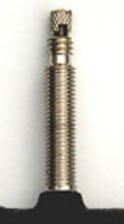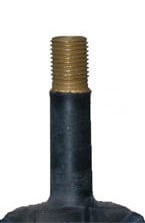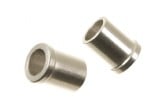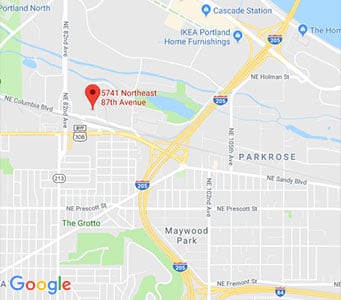Tube Types
Valve Types - Presta and Schrader
There are two standard valve types used for bicycle tubes. These are called Presta and Schraeder (sometimes spelled Schrader or Shrader). Schraeder valves are the kind used for automobile tires and are commonly used on lower-priced bicycles in the United States. Presta valves are commonly used in Europe and on higher-end bicycles everywhere.
Presta valves are used on all tubular (sew-up) tires and are lighter and more aerodynamic than Schraeder valves. The narrower profile also allows them to fit more easily inside narrow rims found on road bikes. And since the Presta valve can be locked closed, it is more resistant to leaking when the tire is pumped up to high pressures.
Presta valves do have a couple disadvantages. Since the valve release is exposed, it is easier to knock it as you release the pump, releasing pressure from the tube. And the valve stem is slightly more fragile than a Schraeder stem.
Overall, we strongly prefer Presta valve tubes and recommend these exclusively. They can be used as replacements for both Presta and Schrader tubes (see info on replacing Schrader tubes with Presta on page 2 of this Tube Types article), and they work better with most bicycle pumps and inflators.


Tube Material - Butyl and Latex
The material used for most bicycle tubes is butyl rubber. Butyl is relatively low cost and holds air pressure for a long time. Butyl tubes come in various weights. Standard weight tubes weigh approximately 95 grams for a normal size road tube (700c x 23mm). Lightweight tubes weigh about 10 grams less. Finally, ultralight tubes save another 10 grams. The lighter weight tubes have less material, but they are also made with tighter manufacturing tolerances so the material thickness is more consistent throughout the tube.
Since inner tube weight is rotational weight at the periphery of the wheel, saving a few grams actually does make a difference in how fast your wheels will accelerate. If you're racing or an avid recreational cyclist that likes to ride fast, consider the lighter weight tubes. If you're not worried that much about the weight, the heavier tubes will be slightly more puncture resistant and will save you a little money.
The most expensive tubes are made using latex instead of butyl. Latex has more elasticity and less stiffness than butyl, resulting in a smoother ride and improved efficiency. Most of the energy lost due to "rolling resistance" is due to the heat loss as the tire and tube deform as the wheel rotates. Since Latex is not as stiff as buytl, less heat is lost during this process. The reduction in energy loss is fairly subtle, but if you're racing every little bit counts.
Latex tubes are also lighter, less prone to pinch flats, and more resistant to puncture flats than butyl, even though lighter weight. So why isn't latex the obvious choice? Well, it is considerably more expensive and also doesn't maintain pressure as well. You'll have to pump up your tires every day (which you should do anyway) if you're using Latex. Plus they flat more dramatically and cannot be patched with a patch kit.
Tube Sizing
Butyl and latex are both fairly elastic, so it's not critical to use a tube that is exactly the correct size for your tire. For example, most road tubes are specified as 700c x 18-23mm. These tubes can easily be used in a 700c x 25mm tire, or a 27 x 1" tire. The rubber will just be stretched a little thinner than it would be in a narrower tire. If you want thicker rubber, you can use a slightly bigger tube. For example, the a tube designed for tires 700c x 28-32mm can be used with a 700c x 25mm tire. We generally don't recommend this because minimal added puncture resistance doesn't offset the added weight in our opinion. It's also easier to make a mistake when installing the larger tube and end up with a pinch flat.
Threaded vs. Smooth Valves
Presta tubes come in both threaded and smooth valve varieties. The threaded valves are like the ones shown in the photo above. They have threads that extend to the bottom of the tube. Threaded valve tubes usually come with a valve nut (knurled metal ring that threads onto the valve stem). This is installed over the valve stem after the stem is inserted through the wheel rim. It's not that critical that these valve nuts be installed, but they will help hold the tube in place when you're inflating it and protect the valve stem from rubbing against the rim as the tire is inflated. Smooth stem tubes don't have this nut, so you need to be particularly careful when pumping up a tire with a smooth valve so that the valve stem does not rub back and forth against the rim. Some people prefer smooth valve stems because it is easier to remove the pump.
If you do use a valve nut, take care not to tighten it too much or it will be difficult to remove when you have to change the tube. Over-tightening can also put pressure on the valve/tube junction where it passes through the rim and possibly cause a flat.
Valve Length
Tubes come with several different valve lengths to accommodate different wheel profiles. Most bicycle wheels will work fine with 32-33mm valve lengths, but higher-end bicycles are often equipped with "aero" wheels which have a higher rim profile, necessitating a longer valve stem. You should have enough valve sticking through the rim to easily attach your pump. With most pumps and inflators, about a half inch will do the trick. If you think you might have a problem with the shorter valve length, using a longer valve tube will not cause any real problems. The only real downsides are increased aerodynamic drag and weight (both of which are pretty minimal) and aesthetics. Mid-length valves come in 48-52mm lengths and the longest run 60-80mm.
If you have a very deep rim profile, even the longest valve stems may not be adequate. For these cases, we sell Presta valve extenders, which screw onto the standard Presta valve to add additional length.
Replacing a Schrader tube with a Presta tube
 It's relatively easy to use a Presta valve tube in place of a Schrader valve tube. The Presta valve has a smaller diameter than a Schrader valve, so will easily fit through the hole in the rim. However, there is a small risk that the valve will move around in this larger hole, possibly damaging the valve and causing a flat. The easiest way to prevent this is to use a Presta stem saver (shown here) which slides over the Presta valve to fit snuggly in the larger rim hole. These should be installed on the tube before inserting them through the rim.
It's relatively easy to use a Presta valve tube in place of a Schrader valve tube. The Presta valve has a smaller diameter than a Schrader valve, so will easily fit through the hole in the rim. However, there is a small risk that the valve will move around in this larger hole, possibly damaging the valve and causing a flat. The easiest way to prevent this is to use a Presta stem saver (shown here) which slides over the Presta valve to fit snuggly in the larger rim hole. These should be installed on the tube before inserting them through the rim.
Using a Schrader Pump with a Presta Tube
 If you're used to using a conventional Schrader pump or air compressor (perhaps at the local gas station) to pump up your tires, you can still do this with Presta valves—although we don't recommend this, it can work in a pinch. By screwing a Presta valve adapter (shown here) onto your Presta tube, you can pump it up with a Schrader pump.
If you're used to using a conventional Schrader pump or air compressor (perhaps at the local gas station) to pump up your tires, you can still do this with Presta valves—although we don't recommend this, it can work in a pinch. By screwing a Presta valve adapter (shown here) onto your Presta tube, you can pump it up with a Schrader pump.
Tire Sealants and SLIME Tubes
Tire sealants are liquids that are put inside tubes to seal small punctures almost instantly. When a puncture occurs, the compressed air inside the tire forces the sealant through the hole at high velocity. When it contacts the low-pressure air, it coagulates to form a seal. This stuff really works to prevent flats. For holes up to 2mm or so, which is most punctures due to glass, thorns, wire and small tacks, the sealants are very effective.
Slime Tube Sealant is optimized for standard butyl tubes. Unfortunately, it can't be inserted through a Presta valve stem because it gums up the valve. To solve this problem, self-sealing tubes are available that have sealant pre-installed. It is also possible to insert sealant into your tube by cutting a small hole in the tube, inserting the sealant, then sealing the hole with a normal tube patch.
Tubular tire manufacturers also make sealant optimized for use with their tires, though these sealants can also be used in other tubular tires. Since the valve core is removable on tubular tires, it is easy to install the sealant and then replace the valve core. Given how hard it is to repair tubular tires, we highly recommend using the sealant. The sealant can be used as a preventative or, after a flat occurs, for repair.
Sealants are also used with tubeless mountain bike and, increasingly, tubeless road set-ups. In these systems, clincher tires are mounted on rims with no tubes. Sealants work the same way with these set-ups as with tubular tires, preventing flats and repairing them as they happen. Some of these sealants include larger particles designed to repair larger punctures that can sometimes occur.
Tire Liners
Another way to minimize flatting is to install tire liners. These are strips of Kevlar or plastic that are inserted in the tire between the tread and the tube. They are basically just adding an extra layer of protection between the tire and tube. While these products do reduce flatting, our preference is to use tire sealants. Most foreign objects that can work their way through the tire casing will also eventually get through a tire liner. Where tire liners really help is in avoiding punctures by larger objects such as thorns that don't embed themselves in the tire.





